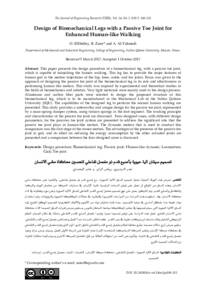Document
Design of biomechanical legs with a passive toe joint for enhanced human-Like walking.
Contributors
Zaier, R., Author
Al-Yahmedi, A., Author
Publisher
Sultan Qaboos University.
Gregorian
2017
Language
English
Subject
English abstract
This paper presents the design procedure of a biomechanical leg, with a passive toe joint, which is capable of mimicking the human walking. This leg has to provide the major features of human gait in the motion trajectories of the hip, knee, ankle, and toe joints. Focus was given to the approach of designing the passive toe joint of the biomechanical leg in its role and effectiveness in performing human like motion. This study was inspired by experimental and theoretical studies in the fields of biomechanics and robotics. Very light materials were mainly used in the design process. Aluminum and carbon fiber parts were selected to design the proposed structure of this biomechanical leg, which is to be manufactured in the Mechanical Lab of the Sultan Qaboos University (SQU). The capabilities of the designed leg to perform the normal human walking are presented. This study provides a noteworthy and unique design for the passive toe joint, represented by a mass-spring damper system, using torsion springs in the foot segment. The working principle and characteristics of the passive toe joint are discussed. Four-designed cases, with different design parameters, for the passives toe joint system are presented to address the significant role that the passive toe joint plays in human-like motion. The dynamic motion that is used to conduct this comparison was the first stage of the stance motion. The advantages of the presence of the passive toe joint in gait, and its effect on reducing the energy consumption by the other actuated joints are presented and a comparison between the four-designed cases is discussed.
Member of
ISSN
1726-6742
Resource URL
Citation
ElDirdiry, O., Zaier, R., & Al-Yahmedi, A. (2017). Design of biomechanical legs with a passive toe joint for enhanced human-Like walking. The Journal of Engineering Research, 14 (2), 166-181.
Arabic abstract
تعرض هذه الورقة البحثية عملية تصميم الساق الآلية الحيوية، مع إصبع قدم ذو مفصل تفاعلي، والقادرة على محاكاة مشي الإنسان. وهذه الساق من المتوقع أن تعمل على توفير السمات الرئيسية لمشية الإنسان في مسارات الحركة من مفاصل الورك والركبة والكاحل وأصابع القدم. وتم التركيز بعمق على نهج تصميم مفصل إصبع القدم التفاعلي للساق الآلية الحيوية وعلى دوره وفعاليته في أداء محاكاة الإنسان. وقد استلهمت هذه الدراسة من الدراسات التجريبية والنظرية في مجالات الميكانيكا الحيوية والروبوتات. وتم استخدام مواد خفيفة جدا بشكل أساسي في عملية التصميم، حيث قمنا باختيار مواد من الألمنيوم والألياف الكربونية لتصميم الهيكل المقترح لهذه الساق الآلية الحيوية التي سيتم تصنيعها في مختبر الميكانيكا بجامعة السلطان قابوس. وسنقوم بعرض قدرات الساق المصممة لأداء محاكاة مشي الإنسان العادي. تعمل هذه الدراسة على توفير تصميما مميزا وفريدا لمفصل أصابع القدم التفاعلي متمثلة في نظام الصمام المنظم الزنبركي الشامل وذلك باستخدام زنبركات ملتوية في جزء القدم. كما تناقش الدراسة مبدأ العمل وخصائص مفصل إصبع القدم التفاعلي. سنقوم بعرض أربع حالات مصممة بطرق مختلفة لنظام مفصل إصبع القدم التفاعلي لتناول الدور الهام الذي يلعبه مفصل إصبع القدم التفاعلي في محاكاة حركة الإنسان. وتعتبر الحركة الديناميكية المستخدمة لإجراء هذه المقارنة هي المرحلة الأولى للعمل. وسيتم عرض مزايا وجود مفصل إصبع القدم التفاعلي في المشية، وتأثيره على الحد من استهلاك الطاقة من قبل المفاصل المحركة الأخرى. وسيتم أيضا مناقشة المقارنة بين الحالات المصممة الأربع.
Category
Journal articles

